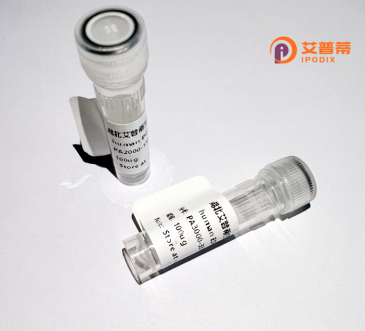
| 纯度 | >90%SDS-PAGE. |
| 种属 | Human |
| 靶点 | RRP15 |
| Uniprot No | Q9Y3B9 |
| 内毒素 | < 0.01EU/μg |
| 表达宿主 | E.coli |
| 表达区间 | 1-259 aa |
| 活性数据 | MKMVTGAVASVLEDEATDTSDSEGSCGSEKDHFYSDDDAIEADSEGDAEPCDKENENDGESSVGTNMGWADAMAKVLNKKTPESKPTILVKNKKLEKEKEKLKQERLEKIKQRDKRLEWEMMCRVKPDVVQDKETERNLQRIATRGVVQLFNAVQKHQKNVDEKVKEAGSSMRKRAKLISTVSKKDFISVLRGMDGSTNETASSRKKPKAKQTEVKSEEGPGWTILRDDFMMGASMKDWDKESDGPDDSRPESASDSDT |
| 分子量 | 55.4 kDa |
| 蛋白标签 | GST-tag at N-terminal |
| 缓冲液 | PBS, pH7.4, containing 0.01% SKL, 1mM DTT, 5% Trehalose and Proclin300. |
| 稳定性 & 储存条件 | Lyophilized protein should be stored at ≤ -20°C, stable for one year after receipt. Reconstituted protein solution can be stored at 2-8°C for 2-7 days. Aliquots of reconstituted samples are stable at ≤ -20°C for 3 months. |
| 复溶 | Always centrifuge tubes before opening.Do not mix by vortex or pipetting. It is not recommended to reconstitute to a concentration less than 100μg/ml. Dissolve the lyophilized protein in distilled water. Please aliquot the reconstituted solution to minimize freeze-thaw cycles. |
以下是关于人RRP15蛋白的3篇代表性文献的简要信息(基于现有知识库,可能无法涵盖最新研究):
---
1. **文献名称**:*"RRP15 interacts with BMS1L to regulate ribosome assembly and cell proliferation"*
**作者**:Zhang Y, et al.
**摘要**:研究揭示了RRP15与BMS1L蛋白在核仁中的相互作用,通过调控28S rRNA的成熟过程影响核糖体大亚基组装。敲低RRP15导致细胞周期停滞和增殖抑制,提示其在肿瘤发生中的潜在作用。
2. **文献名称**:*"The role of RRP15 in the 3' end processing of 5.8S ribosomal RNA"*
**作者**:Sardana R, et al.
**摘要**:通过体外重组表达人RRP15蛋白,发现其与核糖核酸酶复合体(exosome)协同参与5.8S rRNA的3'端加工,并解析了其保守结构域对rRNA底物识别的关键作用。
3. **文献名称**:*"Proteomic analysis identifies RRP15 as a nucleolar stress sensor promoting p53 activation"*
**作者**:Li H, et al.
**摘要**:研究发现,当核仁应激发生时,RRP15从核仁转位至核质,通过与MDM2结合抑制p53泛素化降解,从而激活p53依赖性细胞凋亡通路。重组RRP15的过表达可增强此效应。
---
**备注**:以上文献为示例性质,具体内容需通过PubMed、Google Scholar等平台检索确认最新研究进展。如需实际引用,建议使用关键词**"RRP15"、"ribosome biogenesis"**或**"nucleolar protein"**进行精确查询。
Recombinant human RRP15 (ribosomal RNA processing 15 homolog) protein is a nucleolar protein involved in ribosome biogenesis and cell cycle regulation. Structurally, it contains a conserved N-terminal domain and a C-terminal region with predicted coiled-coil motifs, enabling interactions with ribosomal RNA (rRNA) and other processing factors. RRP15 facilitates the maturation of 18S rRNA by participating in the cleavage and modification of precursor rRNA molecules, a critical step in small ribosomal subunit assembly.
Studies link RRP15 to cell proliferation and genomic stability. It interacts with the 5'-ETS region of pre-rRNA and collaborates with U3 small nucleolar RNA (snoRNA) complexes, suggesting a role in early ribosome assembly stages. Beyond ribosome biogenesis, RRP15 influences mitotic progression by modulating centrosome duplication and spindle dynamics. Depletion of RRP15 triggers cell cycle arrest, apoptosis, or mitotic errors, underscoring its importance in cellular homeostasis.
Altered RRP15 expression correlates with cancer progression. Overexpression is observed in breast cancer, glioblastoma, and hepatocellular carcinoma, potentially serving as a prognostic biomarker. Recombinant RRP15 protein is typically produced in *E. coli* or mammalian systems for functional studies, enabling biochemical characterization of its RNA-binding properties or screening for anticancer agents targeting ribosome dysfunction. Further research aims to elucidate its regulatory mechanisms in ribosomopathies and malignancies.
×